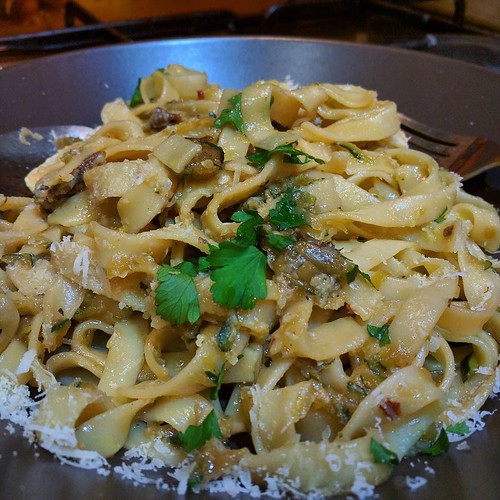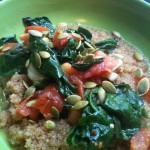Wow – it’s been nearly 2 years since I posted here, really? Well, I haven’t experimented with or adapted a recipe in so long that was so good! This one was just a make-it-up-as-I-go along recipe… so, here goes. It’s definitely vegetarian, but could easily be vegan if you omit the parmesan. Maybe dust with some yeast flakes? Not sure how that would do flavour-wise, but it’s worth a try!
Ingredients
- 3 Tbsp olive oil
- 2 cloves of garlic, pressed or minced (I tend to press 1 clove, but leave it whole, and then mince or grate the other clove)
- 1 tsp marmite
- 1/2 tsp dried red chilli flakes (or to taste)
- 1 medium sized zucchini, roughly shredded or grated
- 2 Tbsp dried porcini mushrooms
- 1 cup water, boiling
- 1/3 to 1/2 cup vegetable stock or white wine
- salt and pepper
- dried tagliatelle — enough for 3-4 servings
- 1/2 cup grated parmesan cheese
- 2 Tbsp chopped flat-leaf (Italian) parsley
Preparation:
Prepare the tagliatelle according to package directions, setting a timer to ensure the pasta cooks al dente.
Boil the water and add the porcini mushrooms to soak.
Heat the olive oil in a large skillet or frying pan over medium-low heat. When warm, add the garlic. When the garlic starts to smell, add the marmite and chilli flakes, stirring to break up and dissolve the marmite.
After the marmite has dissolved, add the grated zucchini to the pan and sauté for 3-5 minutes, allowing the zucchini to release its liquid. Stir occasionally, and add a sprinkle of both salt and pepper.
Add half the stock to the pan and turn up the heat slightly. Allow to simmer, to reduce the liquid a bit, for 3-4 minutes. In the meantime, drain the mushrooms and squeeze dry. Add half the mushroom broth to the pan also.
Chop up the porcini mushrooms and add to the pan, stirring.
Reserve the vegetable and mushroom stock and add as necessary once the ragú begins to thicken; every few minutes, thin it out with some stock and allow to reduce again. Taste, and add salt, pepper, and chilli flakes to taste. Continue cooking until the sauce reduces to your consistency of choice. A ragú should be thick but not chunky or gummy, with enough liquid to coat the pasta it will be served with. Continue tasting and adjusting seasoning as necessary.
When the ragú reaches the appropriate consistency, remove from heat or turn down to the lowest heat possible.
Once cooked, drain the pasta, rinse with cold water, and toss with another tablespoon of olive oil.
Add the pasta to the same pan as the ragú; toss to coat the pasta completely. Leave in the pan for 3 minutes, tossing occasionally, to allow the pasta to soak up some of the flavour of the sauce.
To serve, dish into pasta bowls, dust with some parmesan and toss slightly. Garnish with chopped parsley and a fresh drizzle of olive oil.
Serves 4 (or 3 very hungry people! hah).




